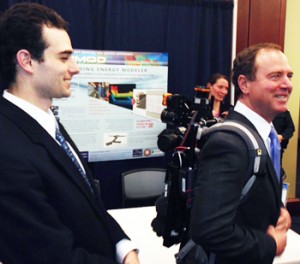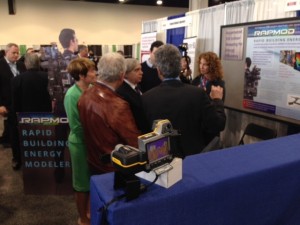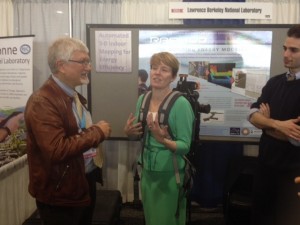A research team from Berkeley Lab and UC Berkeley appeared on Capitol Hill Thursday (Feb. 27) to show off their innovation in energy efficiency: a backpack-mounted system for quickly mapping energy use throughout a building and identifying ways to reduce it.
The project was selected to participate in a reception hosted by The Center for Clean Energy Innovation and the Information Technology and Innovation Foundation on Capitol Hill called Energy Innovation on the Hill, which followed the annual Energy Innovation Summit in Washington, D.C., held by ARPA-E, the federal Advanced Research Projects Agency-Energy. The agency is part of the Department of Energy and funds the backpack project, along with several other lab projects.
Taking their invention back east were Phil Haves, leader of Berkeley Lab’s Simulation Research Group and the project’s principal investigator, along with his UC Berkeley partner, engineering professor Avideh Zahkor, and Eric Turner, a Berkeley graduate student in electrical engineering and computer science.
In addition to taking part in the Capitol Hill reception, the group met with individual members of Congress and their staff to demo the backpack system, and were invited to participate in a Bicameral Roundtable on Climate Change, founded by U.S. Reps. Henry Waxman, D-Calif., and Sen. Sheldon Whitehouse, D-Rhode Island.
The backpack system, Rapid Building Energy Modeler (RAPMOD), uses laser sensors and computers to quickly make three-dimensional thermal maps of an entire building as a person walks through it. The maps allow for a cost-effective evaluation of heat loss and building inefficiencies and could help building owners develop strategies to for making their buildings more energy-efficient, according to ARPA-E.

UC Berkeley engineering grad student Eric Turner looks on as U.S. Rep. Adam Schiff, D-Calif., a member of the House Appropriations Committee, tries on the energy-mapping backpack system invented by a team of researchers from Berkeley and Berkeley Lab. (UC Berkeley photo by Michelle Moskowitz)
The project has the potential to play a significant role in national efforts to reduce energy use and greenhouse gas emissions, and could also reduce costs for consumers, according to the research team.
The backpack-system-as-building-mapper concept originated with Zakhor, a researcher who leads Berkeley’s Video and Image Processing Lab. In the five years since she developed the idea, it has been adapted to multiple uses, while strides have been made to make such systems smaller and ever more accurate.
RAPMOD wasn’t the only Berkeley Lab project getting attention. Besides RAPMOD, four other Berkeley Lab-led projects also exhibited at the ARPA-E Summit’s Technology Showcase, while the Lab’s Delia Milliron and Venkat Srinivasan were panelists in two different Summit sessions.
–Written with assistance from Carol Ness, UC Berkeley Public Affairs

